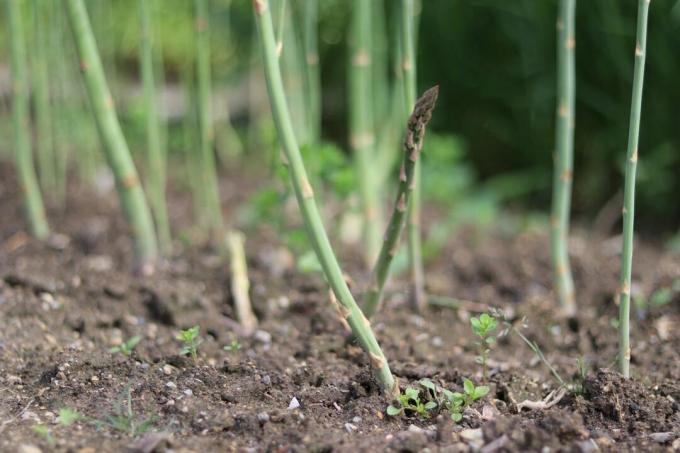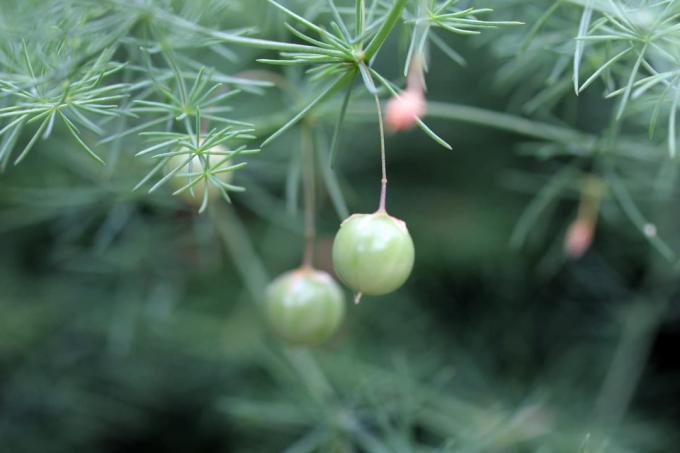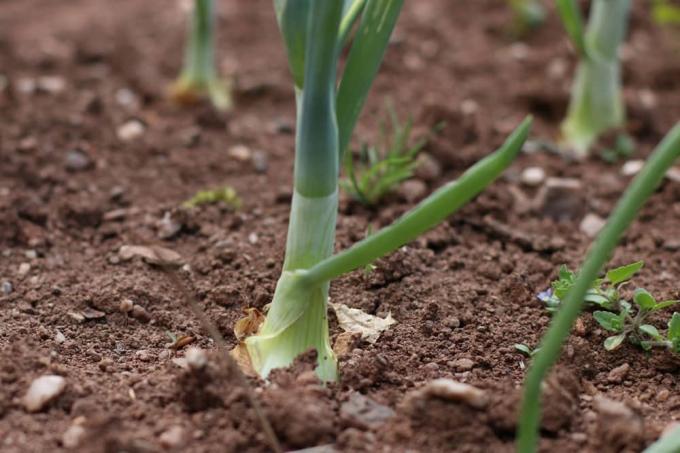

Table of contents
- Characteristics
- sow seeds
- choose location
- Dig an asparagus trench
- improve soil
- insert rhizomes
- promote plant health
- Cut off winter weed
- prepare for the following season
- create a dam
Asparagus is one of the oldest cultivated plants, the cultivation of which took place around 5,000 years ago. To this day, asparagus spears are very popular in spring. This applies equally to white and green vegetables.
Characteristics
- scientific name: Asparagus officinalis
- other names: vegetable asparagus or common asparagus
- Origin: Southern and Central Europe, Near East and North Africa
- natural habitat: warm and temperate regions, preferably on river banks
- Flowering period: from June to July
- widespread landraces: 'Ruhm von Braunschweig' and 'Huchels performance selection'
sow seeds
Asparagus seeds can be sown from March in planters that you have filled with nutrient-poor potting soil. The individual seeds are placed in rows eight to ten centimeters apart and covered with soil one centimeter thick. From mid-May, the young plants can move into individual pots, in which they are cared for until the next season. Since this method increases the maintenance effort, many hobby gardeners switch to buying early young plants.

choose location
In order not to endanger the health of the plants, you should not create the bed in the foreground of hedges or directly next to bushes. When it comes to moisture levels, Asparagus officinalis values balance. The soil should be neither too dry nor too moist. Soils that tend to waterlogging are just as unsuitable for growing the asparagus plant as shady areas or stony subsoil. In order for tender asparagus spears to develop, the basics have to be right. The asparagus requires these conditions:
- sunny locations with warm conditions
- airy place in the open space
- fresh substrates with a loose structure
- loamy soil that has sandy characteristics
Tip:
The cultivation of green asparagus is easily possible in the raised bed. Since white asparagus needs to be protected from light and needs thicker layers of soil, you should also raise the walls with a wooden frame.
Dig an asparagus trench
Autumn is the ideal time of year for this step, because the subsequent soil improvement measures can take full effect by spring. Planting cords prove to be a helpful means of marking when creating larger beds. Smaller ditches can be outlined with a spade. So that the ditch walls are more stable and do not collapse after digging, you should water the substrate lightly before the work. How deep you have to dig the planting trenches depends on the desired color of the poles. White asparagus is later planted at a depth of 25 centimeters, while green asparagus grows 15 centimeters deep. Orient yourself to these values:
- Trench needs a width of 20 to 30 cm
- Compost application depths: 30 cm for green asparagus, 40 cm for white asparagus
- Depths for green manure: 15 centimeters for green asparagus, 25 cm for white asparagus
- pay attention to a row spacing of one meter
- Excavate earth and store excavated material next to the pits
A notice:
If you want to improve the subsoil with green manure, sow deep-rooted legumes such as lupins, soybeans or French beans before digging the planting trenches. The roots loosen up the substrate and digging leaves the plant matter on the surface so that it decomposes into humus.
improve soil
In order for the asparagus plant to find sufficient nutrients in the garden soil, it is advisable to incorporate organic materials such as well-ripened manure or compost in autumn. The biological substances go directly into the planting pits, so that the bottom of the ditch is raised. If you've sown nitrogen-fixing crops in your garden, you don't need to bring in any additional nutrients. It is sufficient if you dig up and loosen the sole well in the spring. How to proceed with soil improvement:
- Distribute organic matter ten centimeters high in the trenches
- Cover with a layer of soil five centimeters thick
- as an alternative to compost, mix in 200 grams of phosphorus and potassium per meter
insert rhizomes
Plant out between March and April before the root rhizomes sprout. The seedlings consist of a bud complex with an elongated to oval shape. The shoots that form the asparagus spears later grow from this structure. When planting, it is important that the specimens are placed in the planting ditches in the same orientation. If the plants are already in bloom, handle the root balls with care. In this way you ensure an optimal starting point for unrestricted growth:
- three to four plants per meter
- spread fleshy root network like a spider on the bottom of the pit
- Lay out the buds of all individuals in the same direction
- spread soil over the roots by hand to keep them in place
- Backfill the trench to about 10 cm below ground level
A notice:
The ditches remain half-open to encourage the asparagus plant to grow. Once the shoot tips pierce the surface, top up with some soil until the trench is filled in by the end of the year.

promote plant health
Proper care is of great importance so that each individual asparagus plant takes root and grows healthily. After planting, watering is recommended, depending on the initial conditions. The soil is often sufficiently moist at this time of year so that you do not have to water it additionally. The emergence of weeds is the main problem for asparagus because root weeds like grasses stunt growth while seed weeds like goosefoot degrade light conditions. How to maintain in the first year:
- Work a handful of organic vegetable fertilizer into the surface of the earth for two linear meters
- regularly pluck out unwanted weeds
- Mulch the bed with completely rotted compost or fall leaves
- Irrigate the area during dry phases so that the substrate remains evenly moist
Tip:
If you sift the mulch material before spreading, you can spread the fine end result thinner and more evenly over the garden bed.
Cut off winter weed
From the beginning of September, the plant draws its energy from the above-ground parts of the plant and stores it in the root rhizomes so that they can sprout with renewed vigor the following spring. In October the yellowing continues until the herb finally appears completely brown. Between mid-November and early December, the foliage has died back, which you can also see from the hollow plant stems. Topping off plants too early will reduce crop yields. Cut this just above the soil surface.
prepare for the following season
Careful tillage of the top layer of soil is recommended to promote new growth. A careful approach ensures that you do not damage the asparagus tips. The focus remains on weeding to keep morning glory, couch grass and thistle from affecting the crops.
This is the correct way to do it:
- Loosen the surface lightly with a rake
- Spread out a fleece in April to protect against late frosts
- give starting fertilizer for vegetables in March
- then renew the mulch layer
create a dam
If you want to harvest white asparagus, you can slightly modify the previous step. After superficial tillage, dig up the soil to the right and left of the rows of plants and pile up the soil to form a ridge over the plants. This should be about 20 centimeters high so that the asparagus shoots are about 30 centimeters thick covered by the substrate. By doing this, you will promote optimal bar length.

Straighten the crown of the ridge and spread a black asparagus foil over the rows. It ensures that the soil warms up optimally and the first harvest can begin soon. The soil warms up faster when growing in a raised bed than in the garden, so you can do without foil in this cultivation.
 garden editorial
garden editorial I write about everything that interests me in my garden.
Learn more about types of vegetables

Can you eat beetroot raw!? Healthy or dangerous?
Beets are tasty and healthy. As a rule, however, they will only be eaten cooked. But could you eat them raw? Yes, you could, beetroots are not poisonous. However, there are some disadvantages associated with it. More about this here.

Grow Peanut Plant | 10 tips for growing peanuts yourself
Peanuts are a popular snack. Whether in muesli, as a small snack between meals or as an ingredient in hearty dishes. They are tasty and, if consumed in moderation, bring health benefits. How good that you can draw them yourself.

Old Fruits & Vegetables | 26 historical & forgotten varieties
Among the historical varieties there are vegetables and fruits with an incomparable variety of tastes. Nevertheless, numerous varieties have disappeared or been forgotten. Lovers of old varieties make it possible for the precious treasures to be brought back into the focus of self-sufficient gardens.

Growing onions, sweet onions - sowing, planting and care
Onions can be cultivated in three different ways: you can plant onions, bring onions outdoors as direct sowing, and onions can be brought forward and then planted or cultivated. put. More and more people are now planting their own bulbs in the garden. For beginners, this may all sound a bit complicated. It's not difficult though. Practice makes perfect and the great sense of achievement comes at the latest with the harvest.

Growing radishes: sowing the plants, caring for them, harvesting + storing
Crunchy radishes taste deliciously aromatic with a touch of spiciness. You can easily grow the tubers yourself, in the garden or on the balcony. Here you will find everything you need to know and tips for cultivation. The harvest will be a complete success.

Leeks: How to grow plants properly – winter leeks and leeks
Leeks or leeks are tasty, vitamin-rich onion plants. However, the long, white spear with its slightly bitter-sweet leek taste requires a little more attention than planting, fertilizing and watering. The characteristic whiteness of the poles arises because it is underground and no photosynthesis can take place. Growing leeks: how it works!



